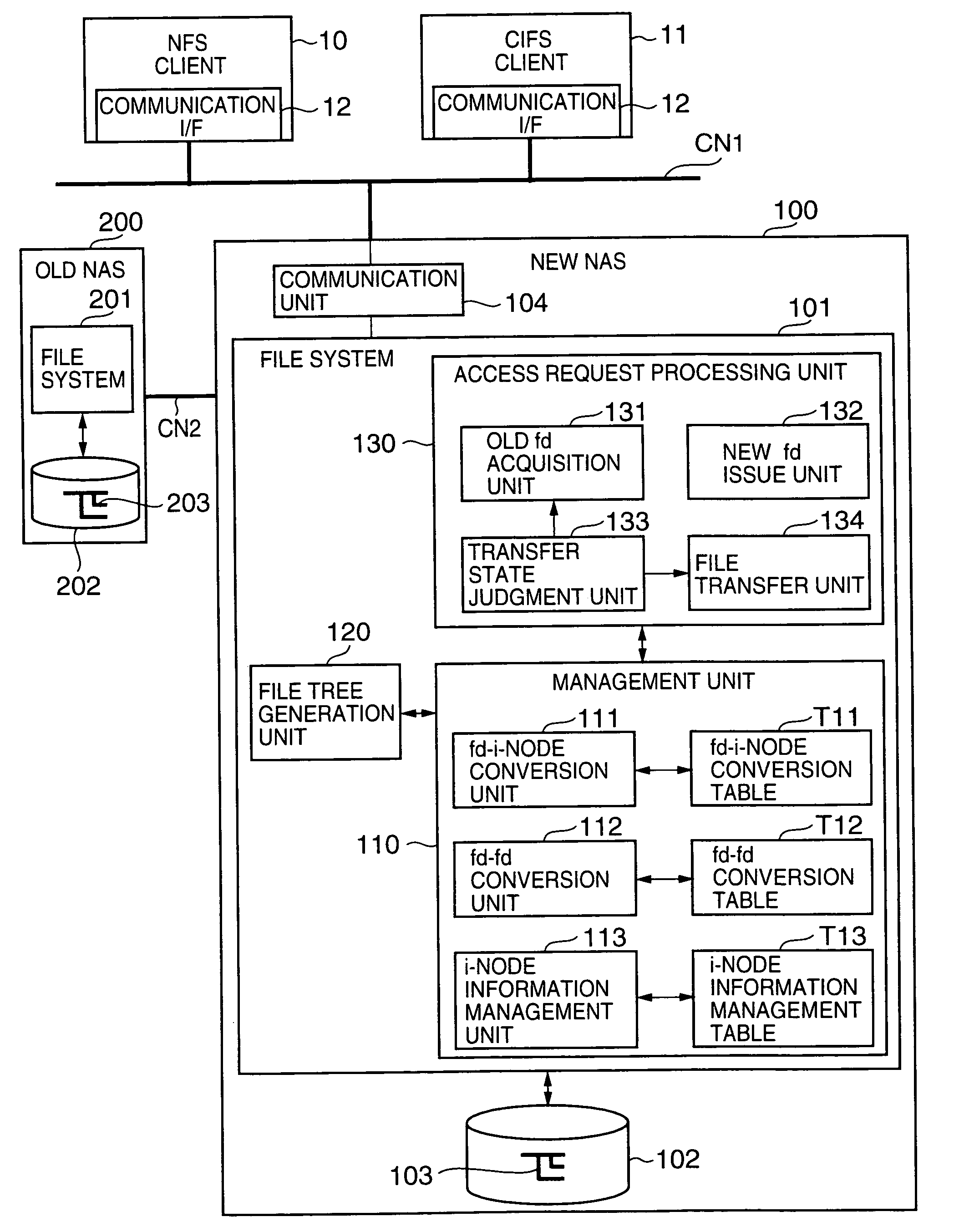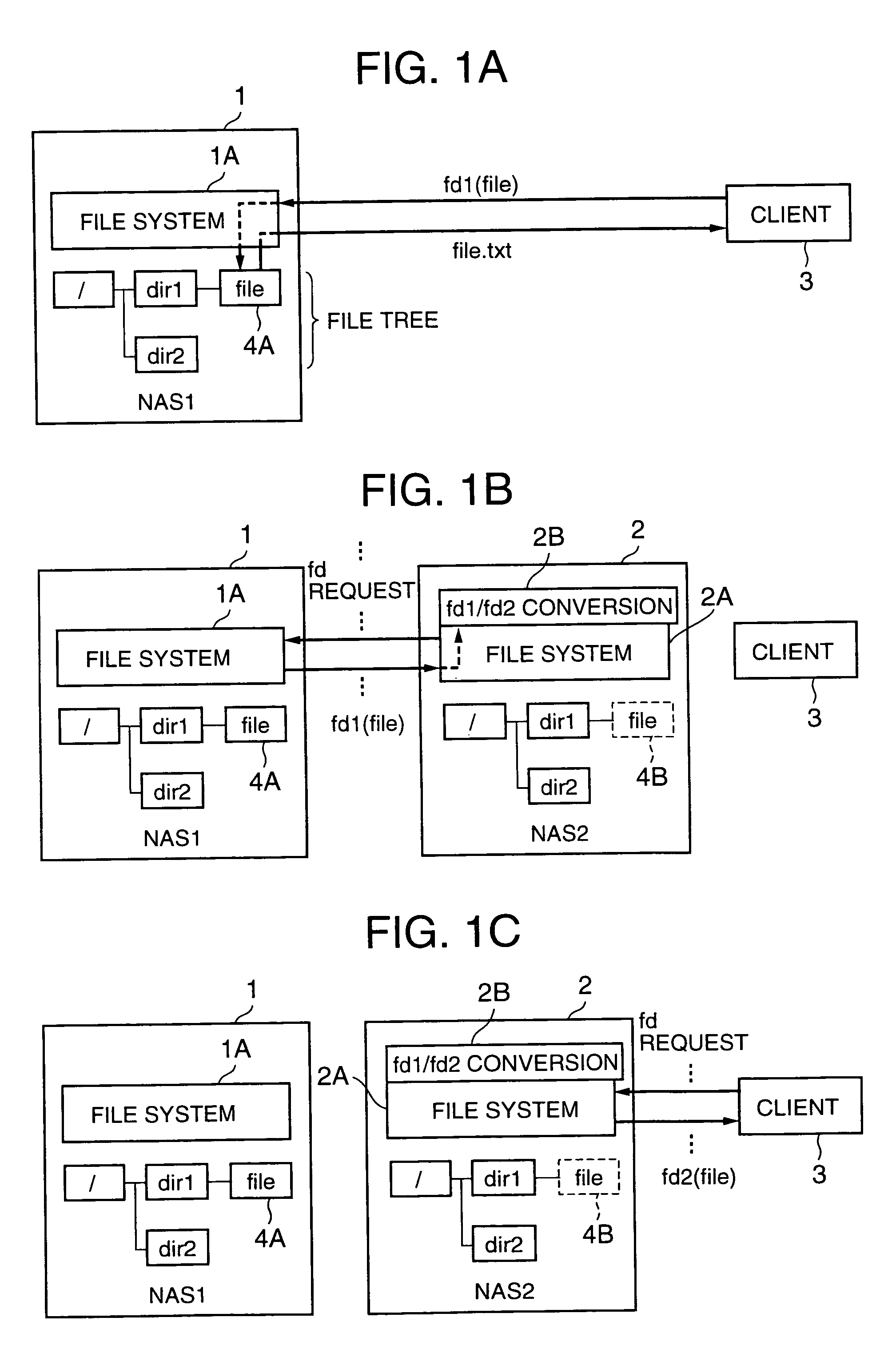Network storage system and handover method between plurality of network storage devices
a network storage and network storage technology, applied in the field of network storage system and handover method between a plurality of network storage devices, can solve the problems of inability to specify the position of the file directly, the shortage of network storage capacity, and the inability of the storage device to specify
- Summary
- Abstract
- Description
- Claims
- Application Information
AI Technical Summary
Benefits of technology
Problems solved by technology
Method used
Image
Examples
first embodiment
1. First Embodiment
[0089]FIG. 3 is a schematic block diagram in which the focus is on the hardware constitution of the network storage system. The network storage system can be constituted comprising a plurality of clients 10, 11, a network storage device 20, and a communication network CN1 that mutually connects the network storage device 20 and the respective clients 10 and 11, as described subsequently.
[0090]The clients 10 and 11 are programs installed on a computer device for using file sharing services (NAS services) provided by the network storage device 20. Here, for example, the client 10 is an NFS (Network File System, registered trademark) client that provides an NFS on a UNIX (registered trademark) OS. Further, the client 11 is a CIFS (Common Internet File System, registered trademark) client that provides a CIFS on a Windows (registered trademark) OS, for example. NFS and CIFS are file access protocols that run on TCP / IP (Transmission Control Protocol / Internet Protocol),...
second embodiment example
2. Second Embodiment Example
[0205]The second embodiment example will be described on the basis of FIGS. 18 and 19. This embodiment example is characterized by the fact that the construction of the association between the old fd and new fd is started when the file tree structure is transferred from the old NAS 200 to the new NAS 100.
[0206]FIG. 18 is an outline flowchart showing the procedure of the overall operation of this embodiment example. The overall operation shown in FIG. 10 differs with respect to P23 and P28. P21 and P22 correspond to P1 and P2 in FIG. 10, P24 to P27 correspond to P3 to P7 in FIG. 10, and P29 to P31 correspond to P9 to P11 in FIG. 10, and hence a repetitive description of the former steps is omitted here.
[0207]When the file tree structure is copied from the old NAS 200 to the new NAS 100, the old fd managed by the old NAS 200 and the i-node number managed by the new NAS 100 are associated and saved in P23. Subsequently, in P28, an association is made between...
third embodiment example
3. Third Embodiment Example
[0211]A third embodiment example will now be described with reference to FIGS. 21 and 22. This embodiment example is characterized in that the file tree structure is copied from the old NAS 200 to the new NAS 100 in accordance with file access by the clients and an association between the old fd and new fd is constructed. That is, this embodiment example permits a transfer from the old NAS 200 to the new NAS 100 in cases where the clients 10, 11 are in an operating state.
[0212]FIG. 21 is a flowchart showing an outline of the overall processing of this embodiment example. First, the network configuration information of the old NAS 200 is handed over to the new NAS 100 (S201) and the old NAS 200 terminates the provision of services to the clients 10, 11 (S202). The system administrator then connects the old NAS 200 and new NAS 100 directly (S203) and allows the task of providing NAS services to be transferred from the old NAS 200 to the new NAS 100 (S204).
[0...
PUM
 Login to View More
Login to View More Abstract
Description
Claims
Application Information
 Login to View More
Login to View More - R&D
- Intellectual Property
- Life Sciences
- Materials
- Tech Scout
- Unparalleled Data Quality
- Higher Quality Content
- 60% Fewer Hallucinations
Browse by: Latest US Patents, China's latest patents, Technical Efficacy Thesaurus, Application Domain, Technology Topic, Popular Technical Reports.
© 2025 PatSnap. All rights reserved.Legal|Privacy policy|Modern Slavery Act Transparency Statement|Sitemap|About US| Contact US: help@patsnap.com



